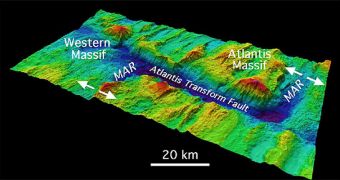A recent expedition scientists lead around the Atlantis Massif led to a discovery that could set the basis for a renewed, deeper understanding of how to map large geophysical structures located beneath the seafloor. This ability stems from a direct analysis of an unusual type of rock.
Using the research vessel JOIDES Resolution, members of the Integrated Ocean Drilling Program (IODP) Expedition 340T were able to discover gabbro and peridotite at the research site. Both are types of rocks that usually exist only deep under the ocean floor.
However, the underwater mountain (seamount) is composed of these types of rocks as well, in addition to others, making it easier for researchers to sample them. Thus far, the only knowledge we've had of these rocks came from seismic surveys.
Usually, seamounts are made up of a hard rock called basalt, but this is not the case with the Atlantis Massif. Thanks to this peculiarity, researchers were able to study the geophysical properties of gabbroic rocks through a direct approach.
Thanks to these data, researchers will be able to better understand how these rocks will look and behave like, during future seismic surveys. In turn, knowing this will enable them to map out larger geophysical structures located deep beneath the oceanic crust.
“This is exciting because it means that we may be able to use seismic survey data to infer the pattern of seawater circulation within the deeper crust. This would be a key step for quantifying rates and volumes of chemical, possibly biological, exchange between the oceans and the crust,” says Donna Blackman.
She holds an appointment as a research scientist with the Scripps Institution of Oceanography (SIO), in La Jolla, California, and was also a co-chief scientist for Expedition 340T. The scientist adds that the Atlantis Massif is located on the flank of a massive oceanic spreading center in the Atlantic Ocean.
“Recent discoveries from scientific ocean drilling have underlined that the process of creating new oceanic crust at seafloor spreading centers is complex,” says IODP program director, Jamie Allan.
“This work significantly adds to our ability to infer ocean crust structure and composition, including predicting how ocean crust has 'aged' in an area, thereby giving us new tools for understanding ocean crust creation from Earth's mantle,” he adds.
Allan is based at the US National Science Foundation (NSF). The organization helped fund Expedition 340T.

 14 DAY TRIAL //
14 DAY TRIAL //